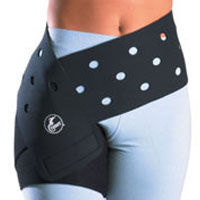Hip Braces
A lot of people who go through hip surgery are fearful that they will not be able to take part in the range of activities they did before the surgery. It's an understandable fear as many people do not understand the treatment, nor do they have sufficient knowledge about the number of devices used to assist the healing process. Hip braces can look very imposing or downright threatening, but the truth is they are very beneficial to the healing process. In fact, hip braces are the most common form of orthotic devices used and they can help correct hip problems and prevent injuries from occurring after surgical operations.
What are hip braces?
These are orthotic devices used for correcting hip problems and give support where needed during normal walking activities. However, hip conditions tend to get worse if not treated, so hip braces can help with the support whilst a patient is waiting for an operation to correct their complaint. Using hip braces can take the strain from the lower back and hips, giving the much-needed comfort and respite.
What do physicians have to say about hip braces?
Physicians have long since recognized the benefits of hip braces to help reduce lower back pain as well as hip pain. The most common application of these braces is among people who have hip injuries. After surgery, hip braces should be worn for a few weeks or months during and after therapy.
Different types of orthotic devices in general
There is a range of different braces available for many different conditions, and this can be one reason why some people are confused about hip braces when they are met with different terms. There are a few different medical terms that refer to the devices. These are: orthosis, orthoses, orthotic devices and hip braces. They are sometimes also referred to as sprints or leg supports too. To make the confusion worse, there are many types of braces available. Here's a quick list of the common types and their applications:
- Ankle braces (ankle orthosis or sprints): These are used for correcting walking problems, more specifically the down foot problem. A person who has a down foot walking problem tends to point the toes downward and drag along the ground
- Foot braces (foot orthosis or sprints): These are used to generally refer to all braces that are worn on the foot. Lower limb braces and foot braces may sometimes refer to lower leg braces, but there is a distinction. Ankle braces, though, can be classified as foot braces
- Lower limb braces are different from hip braces. This terminology is used to refer to the orthotic devices used beneath the hips
- People who have walking problems, or those who feel pain in the hip area, may use hip braces. These braces are different from all lower limb braces and foot braces, not only in terms of positioning, but also in terms of the support offered. Keep in mind that the support needed by the hips is different from that needed by the ankles. This is because the weight distribution in the body can be altered from one ankle to the other. The hips, on the contrary, receive equally distributed weight on the left and right side most of the time.

